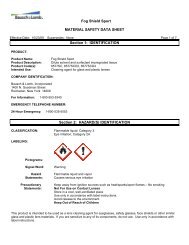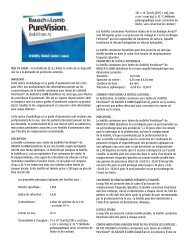Bausch & Lomb Perfecting vision, enhancing life for 150 years A ...
Bausch & Lomb Perfecting vision, enhancing life for 150 years A ...
Bausch & Lomb Perfecting vision, enhancing life for 150 years A ...
You also want an ePaper? Increase the reach of your titles
YUMPU automatically turns print PDFs into web optimized ePapers that Google loves.
manufacturing methods had been per<strong>for</strong>med in<strong>for</strong>mally by members of the<br />
family, but now the growing company required a separate staff to conduct this<br />
work. Operating <strong>for</strong> many <strong>years</strong> with only three or four staff members, the<br />
Scientific Bureau per<strong>for</strong>med the research that made possible the development of<br />
new products and the improvement of old ones.<br />
Be<strong>for</strong>e the decade was out, another relationship was <strong>for</strong>med that would shape<br />
<strong>Bausch</strong> & <strong>Lomb</strong>’s future. By the early 1900s, the Zeiss Company had perfected<br />
its own precision range finders and gunsights in Germany and was eager to<br />
manufacture them in the United States. Zeiss sought to partner with an existing<br />
American firm and turned naturally to <strong>Bausch</strong> & <strong>Lomb</strong>. On December 31, 1907,<br />
Zeiss entered into an agreement with <strong>Bausch</strong> & <strong>Lomb</strong> that was known in<strong>for</strong>mally<br />
as the “Triple Alliance” because it brought together the expertise of three great<br />
optical concerns – <strong>Bausch</strong> & <strong>Lomb</strong>, Saegmuller and Zeiss. With the advent of<br />
this new relationship, <strong>Bausch</strong> & <strong>Lomb</strong> resumed the use of the name <strong>Bausch</strong> &<br />
<strong>Lomb</strong> Optical Company, and Zeiss purchased a one-fifth interest in the company<br />
and granted <strong>Bausch</strong> & <strong>Lomb</strong> free use of Zeiss patents <strong>for</strong> the American market.<br />
Zeiss, meanwhile, continued to manufacture its products in Germany <strong>for</strong> sale in<br />
the rest of the world. The Triple Alliance lasted until just after the outbreak of<br />
World War I, when <strong>Bausch</strong> & <strong>Lomb</strong> bought back Zeiss’s interest. In the<br />
meantime, <strong>Bausch</strong> & <strong>Lomb</strong> had learned much from Zeiss about the development<br />
and improvement of optical measuring equipment.<br />
Meanwhile, Edward <strong>Bausch</strong>’s younger brother, William, was undertaking another<br />
ambitious and important research and development ef<strong>for</strong>t. Until World War I, the<br />
secrets of manufacturing optical glass were closely held. Only three firms in<br />
England, France and Germany could produce optical glass of reliable quality,<br />
and American manufacturers – <strong>Bausch</strong> & <strong>Lomb</strong> included – were entirely<br />
dependent on them. William <strong>Bausch</strong> set out to break the European stranglehold<br />
on optical glass production. In 1902, he developed a method <strong>for</strong> using curved<br />
iron molds to press heated blocks of glass into the approximate shape of finished<br />
lenses. This resulted in a tremendous saving of glass and drastically reduced the<br />
time needed <strong>for</strong> grinding. Still, there was the problem of the glass itself; by 1912,<br />
the company was importing several tons of glass each month. As political<br />
tensions escalated in Europe, the prospect of losing this supply loomed large.<br />
William redoubled his ef<strong>for</strong>ts, building several additional furnaces, locating<br />
materials <strong>for</strong> the clay pots in which optical glass could be melted and identifying<br />
the chemical components and their proper proportions <strong>for</strong> the nine different types<br />
of glass used in the company’s military products.<br />
By June 1915, William had succeeded in producing small quantities of two<br />
different types of optical glass; by early 1917, he had produced enough highquality<br />
glass to manufacture several hundred anastigmatic camera lenses. The<br />
camera manufacturer who tested them pronounced them superior to lenses<br />
made from imported glass.






